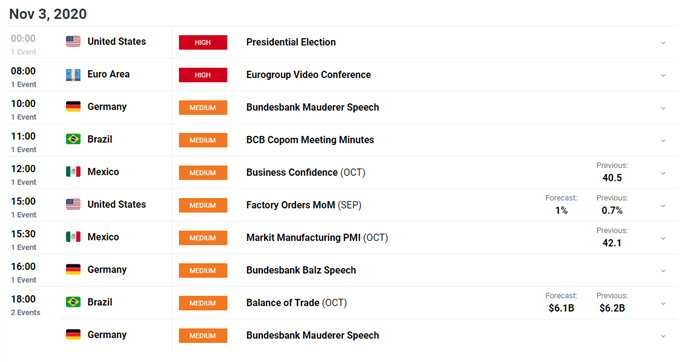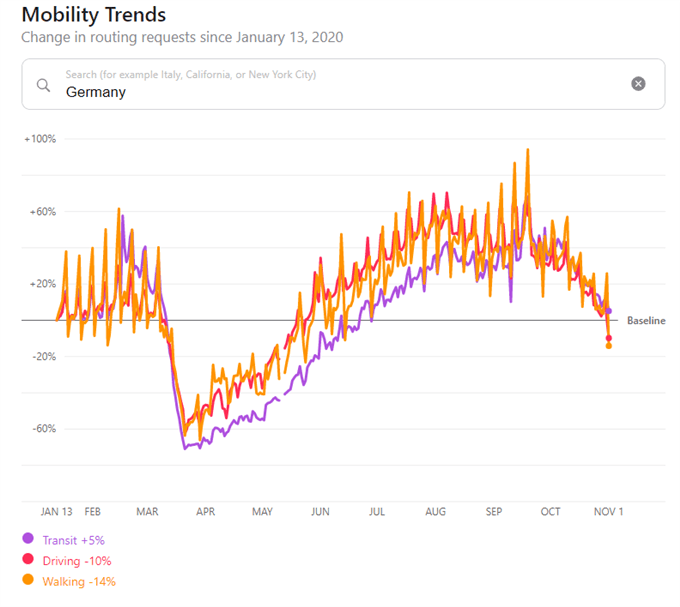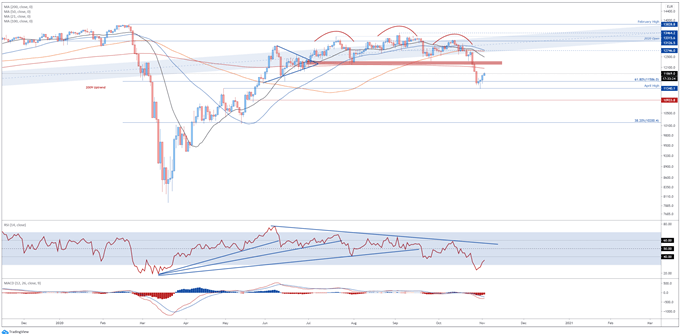DAX 30 Index, German National Lockdown, Mobility Data, Covid-19 – Talking Points:
- Australia’s ASX 200 index stormed higher during APAC trade after the RBA cut interest rates and launched a $100 billion bond purchasing program.
- The imposition of a national lockdown in Germany may weigh on regional risk-sensitive assets in the near-term.
- Germany’s benchmark DAX 30 index is at risk of further losses after breaking below key chart support.
Asia-Pacific Recap
Equity markets continued to move higher during Asia-Pacific trade, as market sentiment appeared to firm throughout the session.
Australia’s ASX 200 index stormed 1.9% higher while the local currency slipped lower against its major counterparts, after the Reserve Bank of Australia cut the official cash rate by 15 basis points and introduced a $100 billion bond purchasing program.
The haven-associated US Dollar and Japanese Yen nudged marginally lower, as investors brace for the upcoming US presidential elections on November 3.
Gold turned lower after failing to breach the $1,900/oz mark and silver prices slipped, as yields on US 10-year Treasuries crept 2 basis points higher.
Looking ahead, US factory orders for September and Mexico’s manufacturing PMI update for the month of October headline the economic docket.

German Lockdown to Cap DAX 30 Index
The imposition of a month-long national lockdown in Germany may continue to put pressure on the benchmark DAX 30 index, as local authorities keep the door open to extending current restrictions if outbreaks aren’t successfully suppressed.
Finance Minister Olaf Scholz stated that “as long as the number don’t go down, there will still be restrictions”, while Chancellor Angela Merkel warned that “the light at the end of the tunnel is still rather far away”.
Moreover, Merkel has implored residents “to refrain from any trip that is not really necessary, any celebration that is not really necessary [and] please stay at home – wherever you are, whenever possible”.

Source – Worldometer
The restrictions are expected to result in a contraction in German economic output in the fourth quarter of 2020 and will likely exacerbate the recent weakness seen in regional fundamental data.
Retail sales unexpectedly fell 2.2% in September while the ZEW Economic Sentiment Index dropped to its lowest levels since May last month.
Indeed, the impact of tightened measures is reflected in high-frequency mobility data, as the number of German’s driving and walking dips below the pre-coronavirus pandemic baseline for the first time since mid-June.
Therefore, local health developments may continue to dictate near-term price action, with a sustained rise in infections increasing the likelihood that lockdown measures will be extended and in turn discounting the benchmark DAX 30 index.

Source – Apple Mobility Data
DAX 30 Index Daily Chart – Psychological Resistance May Cap Upside
From a technical perspective, the DAX 30 index seems poised to rebound back towards the neckline of the Head and Shoulders topping pattern that price collapsed through at the tail-end of October, after forming a bullish Inverted Hammer candle just above key support at the April high (11340.1).
However, with the RSI and MACD indicator travelling firmly below their respective neutral midpoints, the path of least resistance remains skewed to the downside.
Nonetheless, a daily close above the sentiment-defining 200-day moving average (12067.3) would probably generate a push to test the resistance range at 12210 – 12300, with a burst above needed to carve a path back towards the yearly open (13126.5).
Conversely, further losses could be in the offing if psychological resistance at the 12000 mark holds firm, with a daily close below the April high (11340.1) needed to bring the 11000 level into play.

DAX 30 index daily chart created using TradingView
-- Written by Daniel Moss, Analyst for DailyFX
Follow me on Twitter @DanielGMoss

